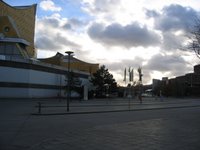
Gelobtes Land—Two Sorts of Charm
In summer 2006, 4,000 rockets fell on northern Israel from Hezbollah forces in southern Lebanon. [1] Today, barely five months later, my visit to the Hula Valley, a rich agricultural strip on the western shore of the Jordan River right below the border with Lebanon, reveals few signs of destruction. Although less targeted than more populous areas like Kiryat Shmona, the area nonetheless received rockets, a fact belied by its current undamaged appearance. Our guide can only point out the smallest traces of war: here is a bunch of yellowed trees that burned when a Katyusha fell nearby; it was aimed at a bridge slightly farther upstream on the river, which is more of an irrigation canal tamed into a straight line than the mythic, war-causing waterway its name calls to mind. And over there--the guide gestures out the window of the Jeep--another rocket fell, but the farmland has been more or less smoothed out and one must squint to convince themselves they see an undulation in the landscape.
To compare apples and oranges, the former East Berlin bears much more obviously the scars of war. While districts of former East Berlin are now central city today, vacant lots from the post-war era remain, as do long, wide, ghostly strips of what was no-man’s land alongside the Berlin Wall during the Cold War. These lots look like dollar signs to investors, even as new projects and dreams then fail, leaving more holes in the cityscape. While growth and change are characteristic of all metropolises, in few do they stamp the city with such vivid pockets of emptiness, a forlorn patchwork mystique.
In contrast, even the military fortifications in the pastoral Hula are picturesque. Pontoon bridges are nestled in the eucalyptus groves alongside the river in case the permanent bridges are ever damaged; their fatigue green paint and patches of red rust match the trees’ light leaves and rich-hued bark. The ruins of Syrians command centers and bunkers only half-destroyed by the conquering Israeli army in 1967 are similarly charming. Bunkers, command centers, and border-crossing customs tollhouses dot the slopes that look down on the farms. They are composed of partial walls and collapsing ceilings, large chunks of grey-yellow cement crumbling down into soil speckled with grey-yellow boulders, as though the layers of military conquest are yet another geologic process slowly taking place on the ancient landscape.
However, the aesthetic of pastoral charm doesn’t always  supercede that of metropolitan creation-and-decay. Berlin’s gritty ugliness has enchanted just as many as it has repelled; residents call it an “interesting” city rather a “beautiful” one. To decode this rag-tag geography, to follow the constant physical developments in the city—the breweries and airports slated for demolition, the new condominiums or office complexes scheduled for construction—is to feel like not just like an insider but also a fellow-traveler through a process compelling in its demonstration of temporality. When buildings are so frequently here today, gone tomorrow, one is keenly aware of existing in a particular, short time window, aware of their own impermanence.
supercede that of metropolitan creation-and-decay. Berlin’s gritty ugliness has enchanted just as many as it has repelled; residents call it an “interesting” city rather a “beautiful” one. To decode this rag-tag geography, to follow the constant physical developments in the city—the breweries and airports slated for demolition, the new condominiums or office complexes scheduled for construction—is to feel like not just like an insider but also a fellow-traveler through a process compelling in its demonstration of temporality. When buildings are so frequently here today, gone tomorrow, one is keenly aware of existing in a particular, short time window, aware of their own impermanence.
 Yet, a variation of this feeling also permeates the Golan Heights, which begin on the Hula’s eastern side. The Hula lies along the pre-1967 border with Syria, and to cross it and ascend the rocky slope on the other side is to tread land that once belonged to another country—a country still calling for it back. The Israeli-occupied Golan is a moonscape of rocky soil and snowy hilltops, fertile pockets of land with white-walled villages tucked inside, and land-mines zones and tanks lying alongside roads. Visiting such terrain is to be reminded of the fragility of borders, of peace, and of personal existence.
Yet, a variation of this feeling also permeates the Golan Heights, which begin on the Hula’s eastern side. The Hula lies along the pre-1967 border with Syria, and to cross it and ascend the rocky slope on the other side is to tread land that once belonged to another country—a country still calling for it back. The Israeli-occupied Golan is a moonscape of rocky soil and snowy hilltops, fertile pockets of land with white-walled villages tucked inside, and land-mines zones and tanks lying alongside roads. Visiting such terrain is to be reminded of the fragility of borders, of peace, and of personal existence.
In both Berlin and the Golan, inhabitants fight to maintain their land and their identity--for example, the Syrian minority refuses to adopt Israeli citizenship despite that government’s pressure, while former-East Berliners protest the rapid gentrification of their environs and draw boundaries between themselves and their neighbors (see post Dec. 23). Yet, as mentioned, such a comparison is like that between apples and oranges: occupied mountains versus a free city, countries versus neighborhoods, decades of mutual injustice versus the changes of modernity. Maybe. What is certain is that each variety of beauty is fiercely clung to, scarring the landscape it enhances, its allure giving rise to territoriality, its vulnerability a product of its appeal.
[1] Steven Erlanger, “The Mideast Crisis: Aftermath; Reservists in Israel Protest Conduct of Lebanon War,” The New York Times, 22 August 2006, p. A11.

No comments:
Post a Comment